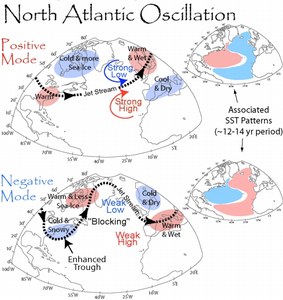Popular Science: What all does solar activity cause?
North Atlantic Oscillation (NAO) is an important climatic mechanism that affects the weather and climate in Europe. Similar to the ENSO process (El Nino – South Oscillation) in the Pacific, the NAO is based on different pressures, which are the driving forces for atmospheric circulation on the Earth. In the case of the NAO we study pressures on Iceland and on the Azorean Islands, so-called Azores high and Icelandic low. The differences between the pressures are changeable, and the NAO either strengthens or weakens. The NAO also brings rain over Europe and it has an impact on the majority of the continent.
 Modes of NAO. Source: http://hockeyschtick.blogspot.co.uk/
Modes of NAO. Source: http://hockeyschtick.blogspot.co.uk/
The authors compared data on pressure and solar activity for the individual months from 1948 to 2012. They found a correlation with eleven-year-long solar cycles. They confirm the relationship between the NAO phases and the number of sunspots. The pressure in the atmospheric centres particularly correlates with winter temperatures. This confirms that the NAO affects Europe more during the winter. If the solar activity increases, the NAO and the pressure differences between the Azores and Iceland also grow. In the NAO’s positive phase the Icelandic low is moving to the east and a lot of cyclones are also arising there, which is indirect evidence that solar activity has an influence on cyclogenesis in this area. Zonal activity is stronger in the NAO’s positive phase and this verifies the NAO’s stronger effect in winter months. Research of the pressure centres led to the conclusion that the Azores high moves to the south when solar activity increases and, on the contrary, in the event of weakened solar activity the Greenland high pressure area moves to the south.
Solar activity does influence pressure centres, though it is less than scientists expected. Higher solar activity causes greater pressure differences among the pressure centres and this has an influence on Europe, including the Czech Republic.
Radan Huth has been interested in the NAO for a long time. In his next article you can read in detail how the climate in Europe is affected by the NAO.
Tomáš JANÍK
Document Actions